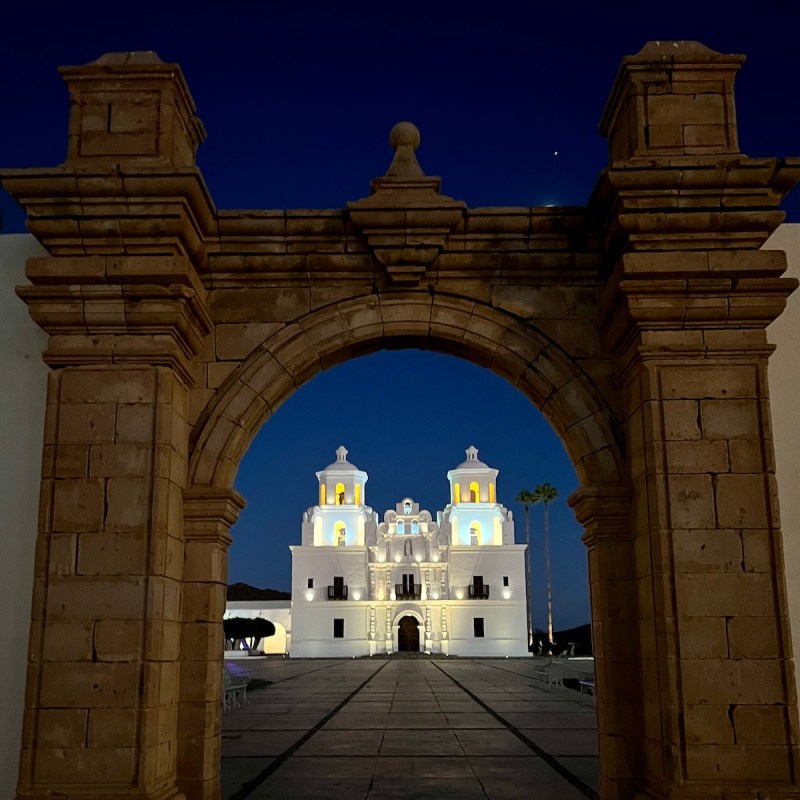
Warm hospitality, centuries of fascinating history, and amazing authenticity come together beautifully in Caborca, Sonora, Mexico — a mid-sized city known in its home country for its ethereal 1600s/1700s-era Mission Church, as well as for its heroic defense of the mission in the 1850s.
Videos by TravelAwaits
Caborca is located far from the beaten path of tourists, about 2 hours southeast of the U.S./Mexico border, 3 hours northwest of the major Sonoran city of Hermosillo, and 2 hours southeast of the popular Sea of Cortez fishing village/tourist destination of Puerto Peñasco (Rocky Point).
Due in part to its remote location, Caborca is largely free of commercial influences from its neighbor to the north. Even though the city has a population of about 68,000 and the municipal area has nearly 90,000 people, it has the feel of a much smaller town, and you won’t find the usual U.S. chain stores or fast-food spots.
Instead, the streets are lined with local mom-and-pop stores, restaurants, and multiple locations of the Mexican convenience-store chain OXXO. It’s all part of the authenticity and charm of Caborca.
I traveled to Caborca recently as a part of the Prescott/Caborca Sister Cities organization from my hometown of Prescott, Arizona. The two towns were celebrating their 50th anniversary as sister cities and there were gala events planned on both sides of the border. The Caborcans rolled out the red carpet (literally) for our group and I was impressed by how warmly the community embraced the sister city partnership.
Pro Tip: Visitors should be aware that the U.S. Department of State’s website lists Sonora among the Mexican states to “reconsider travel to” due to crime and kidnapping. That said, on my November 2022 trip to Caborca, I was traveling with a group, and I never felt unsafe. We were cautioned against driving at night and my nighttime drives were limited to early-evening trips between my hotel and the Old Mission area along busy city streets. As with any travel, visitors to Caborca should remain vigilant of their surroundings.
Here are 8 fantastic things to do in historic Caborca.

1. The Old Mission
Old Town Caborca
The heart of Caborca lies in its photogenic Old Mission (La Purísima Concepción de Nuestra Señora de Caborca), a mission church that dates back to the 1690s when Jesuit missionary Francisco Xavier Saeta became its first priest. Saeta was killed in an uprising by the native O’odham people in 1695 and the original church was burned. Father Eusebio Kino, the priest famous for overseeing a number of the historic Catholic missions of the U.S. Southwest, later brought carpenters to build a replacement church in Caborca between 1702 and 1706.
Starting with its violent beginnings, the mission church has had a turbulent history. It was the site of continued uprisings throughout the 1700s, an 1857 incursion by American mercenaries, and damage from a devastating 1915 flood of the nearby Rio Concepción.
Today, the restored Old Mission is the centerpiece of Caborca’s Pueblo Viejo (old town area). Also known as Templo Historico (historic temple), the Old Mission is a must-see in Caborca. During the day, the temple’s white walls glow in the sunlight, and at dusk, the lighted spires shine against the night sky.

2. The Restored Baptismal Font
History In The Making
One of the fascinating things to see in the Old Mission is the room that holds the original baptismal font — a large vessel that reportedly was taken from the church in the 1930s by a young American woman, purportedly for its protection. Over the decades, the font had been held in the U.S., first in a family collection, and later in an Arizona museum.
Members of the Prescott/Caborca Sister Cities organization worked for nearly 15 years to try to get the font returned to its original home. Finally, in the spring of 2022, the vessel was officially turned over to the Caborca church in a momentous ceremony. Today, it is on display in a room in the church and serves as one of the accomplishments of the bond between the Prescott and Caborca Sister Cities organizations.
3. The Caborca Museum
Museo Histórico Y Etnográfico
Just across the street from the mission is the excellent town museum, the MHEC (Museo Histórico y Etnográfico de Caborca). The museum was remodeled recently and currently has a collection of 80 pieces, including a petroglyph between 3,000 and 8,000 years old, obsidian and quartz arrowheads, charm beads, 18th-century coins, and a replica of the flag from the famous battle of April 6, 1857.
When I visited in early November, the museum was exhibiting wonderful paintings and displays depicting the recent Dia De Los Muertos (Day of the Dead) as well as traditional dances from various states of Mexico, performed by Caborca’s outstanding Grupo de Danza Folclórica, “Mi Tierra.”
4. The 6th Of April Festival
Seis De Abril
Each April, the residents of Caborca celebrate a holiday that is unique to the Sonoran city. The 6th of April holiday is a time for the celebration of the town’s victory over former American soldier Henry Crabb and a team of armed “filibusters” who traveled to Caborca in the spring of 1857 on an unauthorized mission against the Mexican government.
According to Explore Sonora, Caborca residents defended the city for eight days until Crabb and his men surrendered to the Mexican authorities and were later executed. In 1948, Mexico honored the town’s heroics, and Caborca has since been known as “Heroica Caborca.”
Each year, the city has fiestas and parades that culminate on the 6th of April, the day of Crabb’s surrender.
Pro Tip: The parade and other activities may be held on another day if April 6 falls on or near Easter Sunday.

5. Caborca Petroglyphs
Ancient Rock Art
The geographical region that extends south of Caborca and north into what is now Arizona has been inhabited by ancient native people for centuries. The works of rock art from those cultures are on spectacular display in their natural Sonoran Desert environment at the Caborca Petroglyphs, located on a private ranchland just west of Caborca.
The town’s tourism website notes that the Mogollon people inhabited the area from about 600 B.C. to 1400 A.D. Other native cultures have lived in the region through the ages. The petroglyph zone has two main hills that are filled with rock art from ancient cultures. With more than 6,000 rock carvings, the area is said to have the greatest concentration of petroglyphs in Latin America. When I visited, I was fascinated to see the distinctive etchings on rocks at ground level and also high up in the rocky hills.
Because the property is privately owned, visitors need to arrange for tours. Inquiries can be sent to the Viva Caborca website.
6. Leather Goods In Nearby Pitiquito
Home Of Pieles Pitic
For another mission church from the Father Kino era in a small-town atmosphere, take the short drive along Mexico Highway 2 to the Pueblo of Pitiquito. The community is located in the desert hills several miles east of Caborca.
Along with being home to the 1689-era mission church, San Diego de Pitiquito, the town is also the site of Pieles Pitic, a producer of traditional and fine leather goods. The Viva Caborca website notes that Pieles Pitic was founded in 1971 and has long offered hand-crafted leather products from vests and jackets to moccasins and purses.

7. Sonoran Cuisine
Carne Asada, Salsas, And More
When I asked local Caborcans about the food specialty of their region, there was no dispute. Carne asada (grilled beef) was the unanimous choice. Sonora is known for its exceptional beef, carne asada — a grilled, chopped beef dish — is the culinary star in restaurants all over Caborca.
I especially loved the tacos served at the casual, fun restaurant, Asadero Bifalo, and the combination plates at the full-service breakfast, lunch, and dinner restaurant El Timón. The salsas at both places were robust and spicy, the meats were flavorful, and the service was fast and friendly.
8. Day Trip To The Sea Of Cortez
The Tourist Town Of Rocky Point
With the Sea of Cortez just two hours away, it’s hard to resist a trip to the cool tourist town of Puerto Peñasco, also known as Rocky Point.
The town, located about an hour’s drive southwest of the Arizona/Sonora border crossing in Lukeville/Sonoyta, is a popular vacation spot for Sonora residents, as well as Arizona residents. What was once a small fishing village has become a popular beach resort town.
For decades, Puerto Peñasco has been known as an excellent spot for ocean fishing, water sports, and relaxing on the beach.
Among the attractions that I love checking out in Rocky Point are the shops in the Old Port area, the beautiful sandy beach at Playa Bonita, and the Malecón area near the Old Port. Many fun restaurants and bars line the shopping area and multiple hotels and condos are available — both in the Old Port area and the Playa Bonita area.
Information on getting to Puerto Peñasco is available here.
Pro Tip: For hotel accommodations in Caborca, my group enjoyed the El Camino Hotel. The hotel is comfortable and clean, has a gated parking lot, and is easy to get to from the main Highway 2. It has a lovely swimming pool, patio area, and an onsite restaurant and lounge.

When To Visit Caborca
Caborca’s summer temperatures are known to be similar to or even a bit hotter than the sizzling temperatures in Arizona’s desert cities of Phoenix and Tucson. Caborca posts average highs of 107 degrees Fahrenheit in June, 106 degrees Fahrenheit in July, and 105 degrees Fahrenheit in August. The most pleasant months to visit Caborca are October through April when the average highs range from the low 70s in the winter months to the 80s and 90s in the spring and fall.
For more information on traveling to Mexico, check out these articles:
